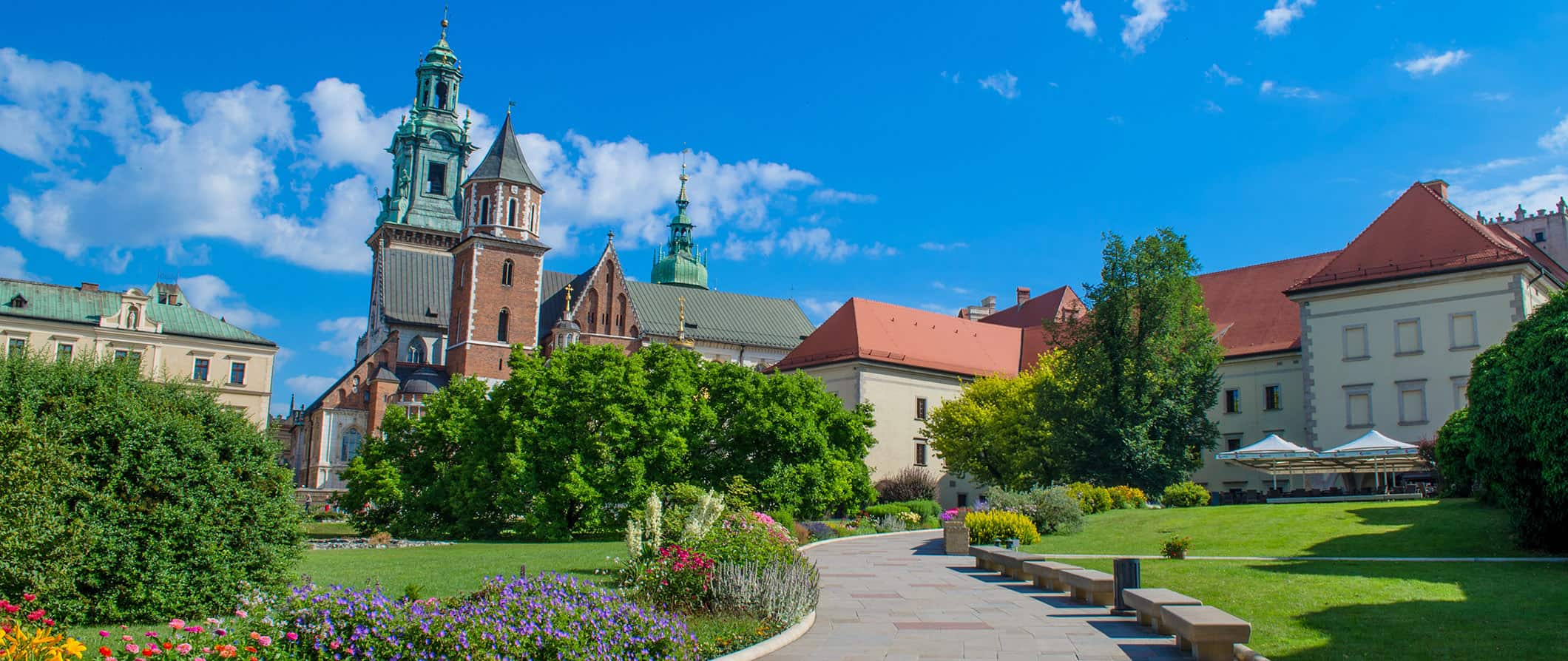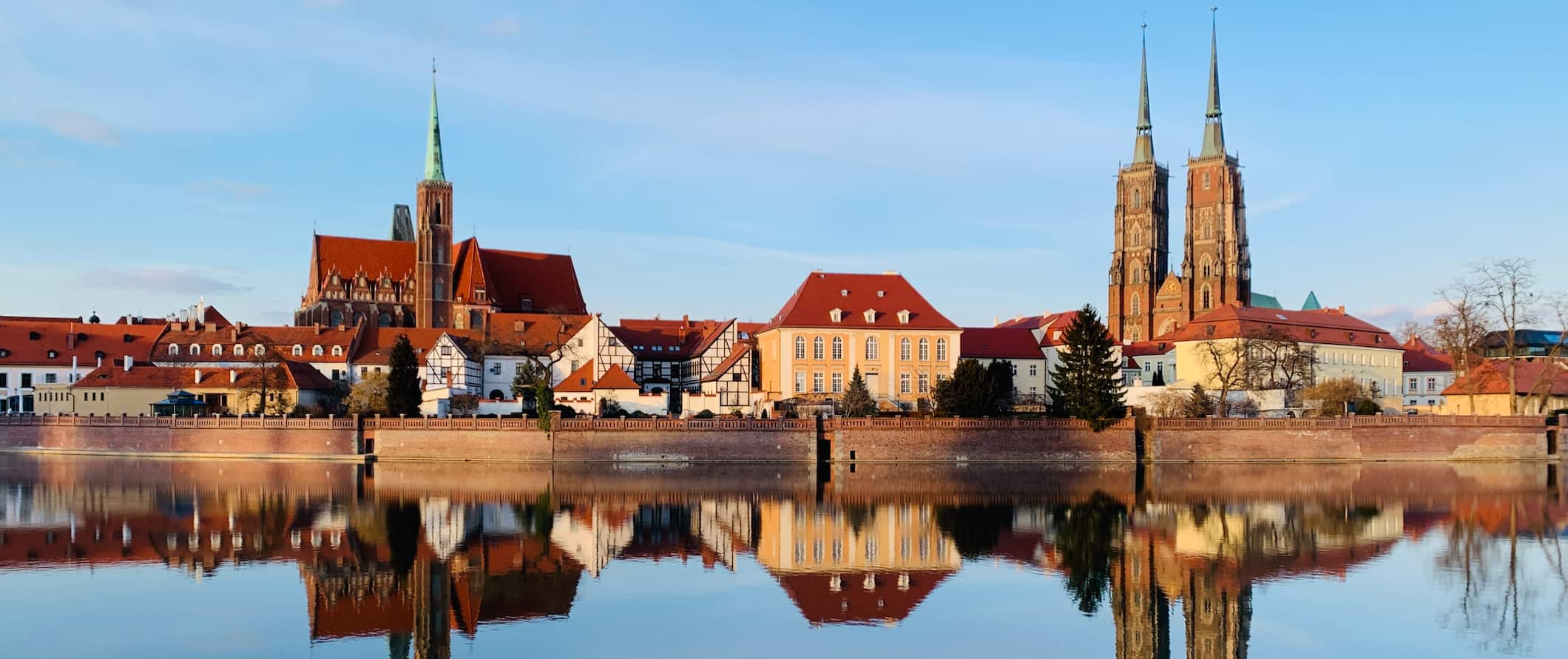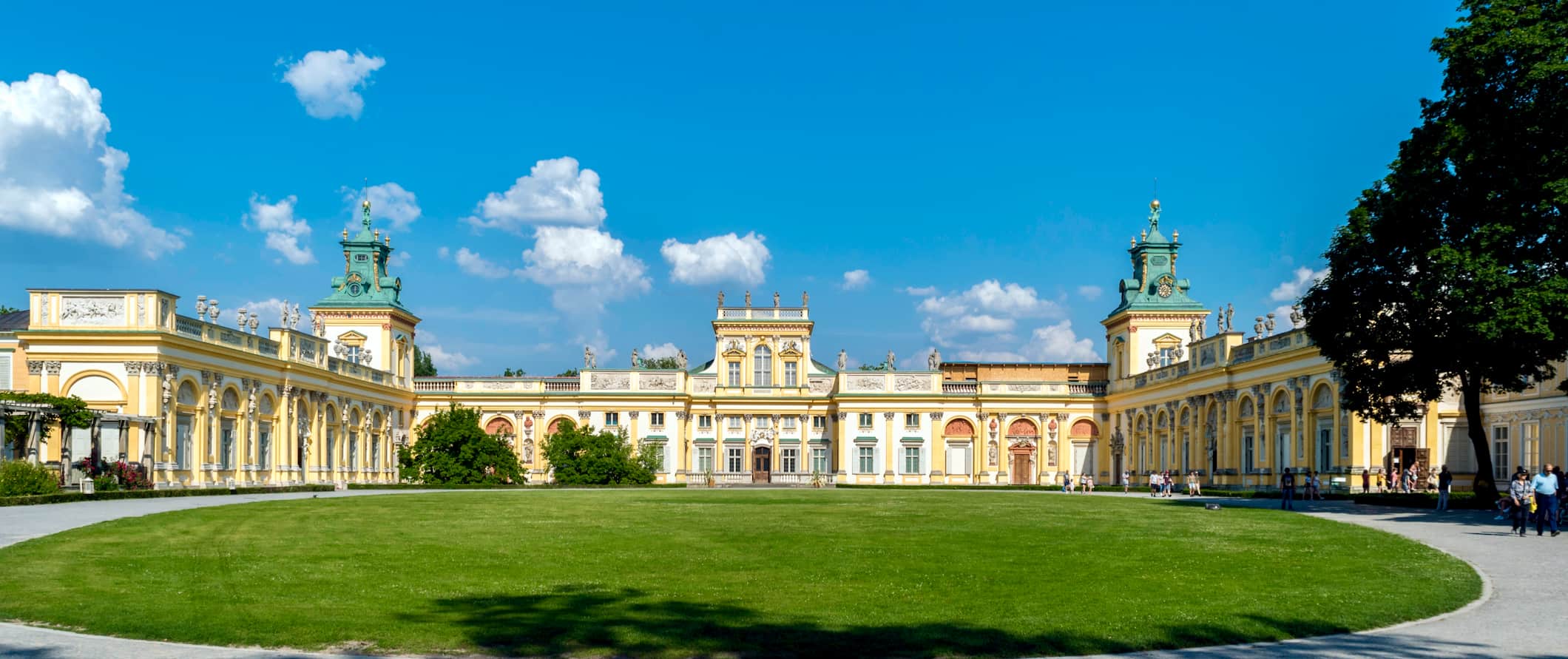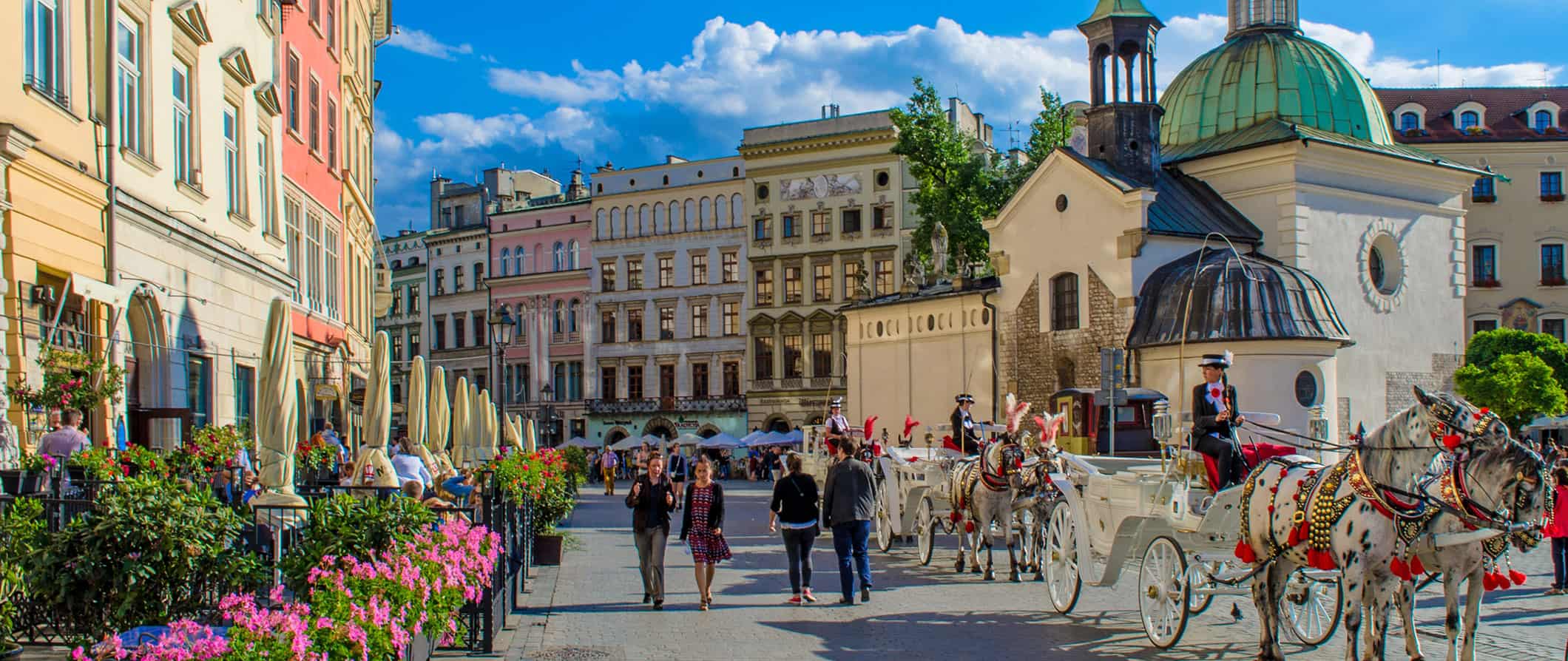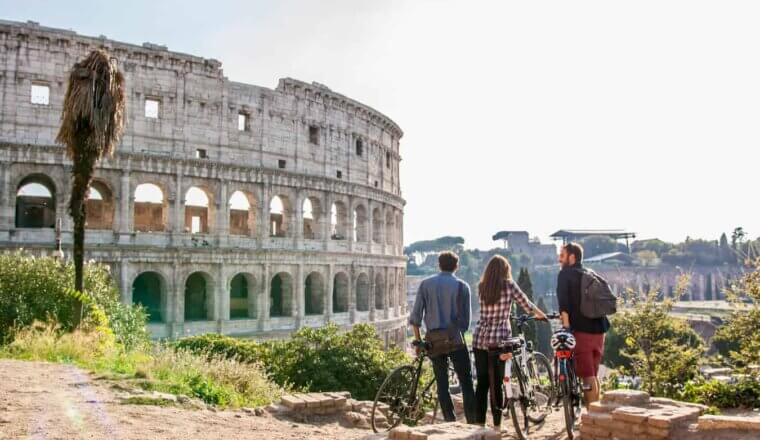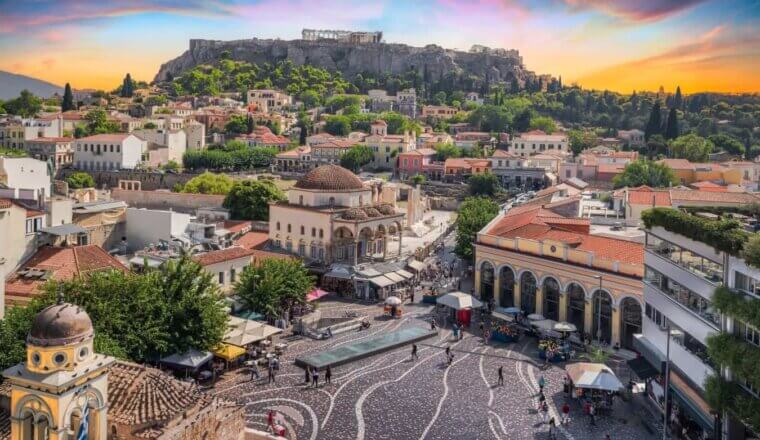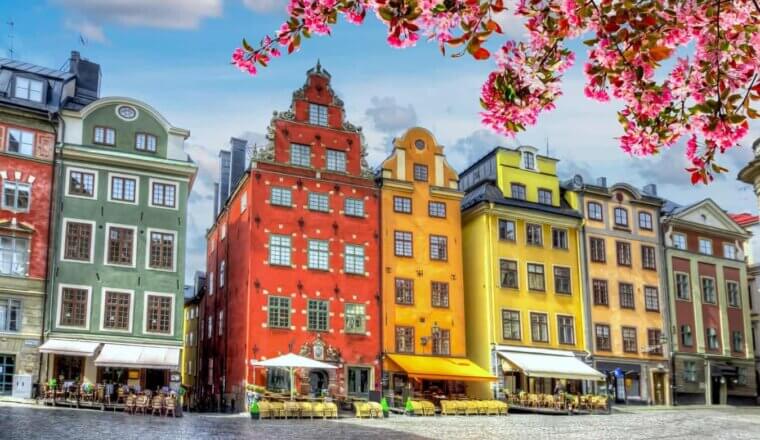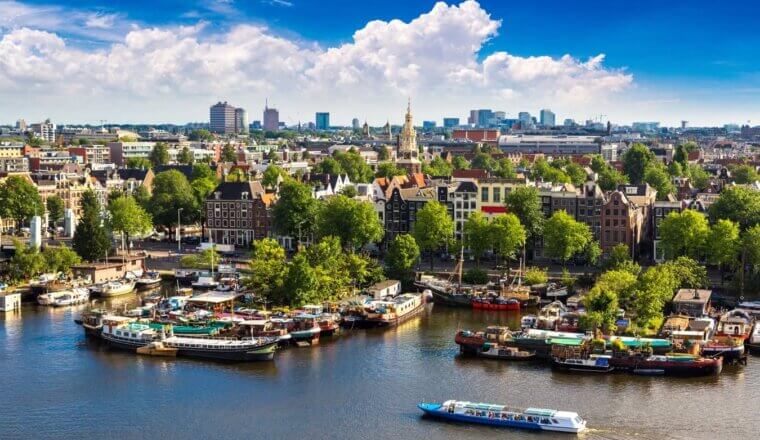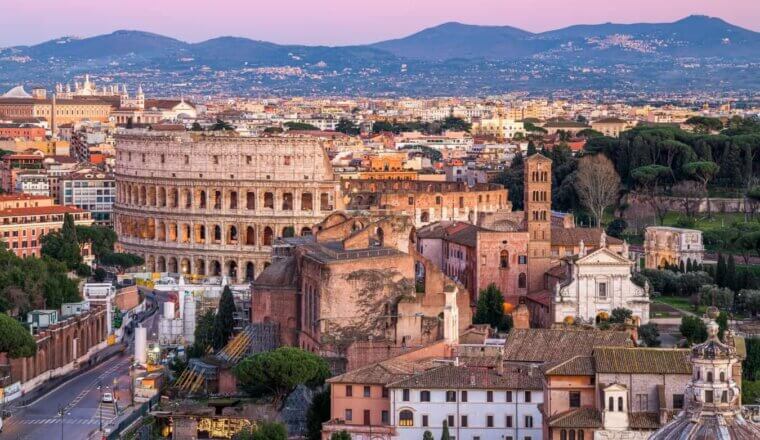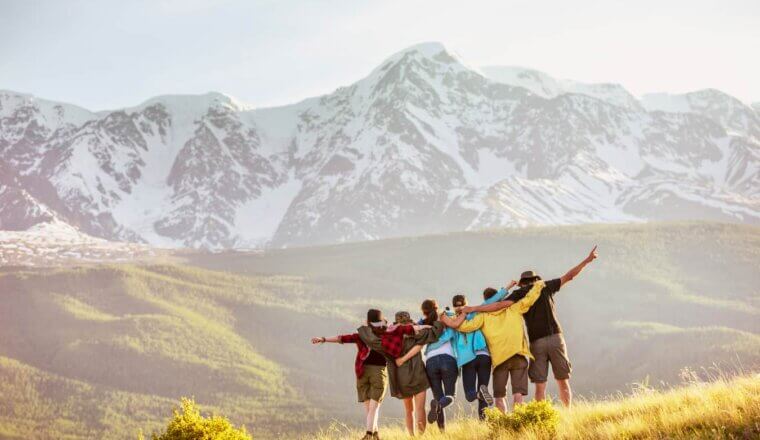Poland is one of the most underrated destinations in Europe. With its incredible history and UNESCO World Heritage Sites, cheap food, world-class museums, wild nightlife, and plentiful nature, Poland is a budget-travel paradise. It has everything you’ll find in Western Europe — but for half the price and with half the crowds!
Most travelers visit Krakow or spend a day or two in Warsaw before departing to a neighboring country. While that’s better than nothing, Poland has so much more to offer.
From beautiful parks to medieval cities to cheap beer to rugged coastlines, you can spend weeks here and still only scratch the surface.
Best of all, there are far fewer tourists here than elsewhere in Europe so it’s easy to have a more local, more authentic experience.
Use this travel guide to Poland to plan your trip, save money, and make the most of your time in this budget-travel paradise!
Table of Contents
Click Here for City Guides
Top 5 Things to See and Do in Poland
1. Visit Auschwitz
Auschwitz-Birkenau is the site of a former concentration camp used by the Nazis during World War II. Approximately 1.3 million people were sent here and an astounding 1.1 million of them were killed. When the camp was liberated in 1945, there were just 7,000 people there, many of whom were incredibly ill or sick. A visit here is sobering but shouldn’t be missed. Wear comfortable shoes as there is a lot of walking and keep in mind you’re allowed to take photographs but be considerate that this is a somber place. Admission is free, but the experience is much more meaningful with a guide who can provide context. Expect to pay around 550 PLN for a guide.
2. Explore Krakow
Krakow is a student city and one of the biggest tourist destinations in the country (people love coming here to party). This city is beautiful, inexpensive, and is filled with plenty to do. Be sure to check out the castle, the nearby salt mines, and underground ruins. The Christmas market in December is amazing too!
3. See Wroclaw
Wroclaw is one of Poland’s lesser-known destinations. Home to some amazing architecture, this small city is beautiful, inexpensive, and free of crowds. Be sure to see the Raclawice Panorama, which depicts the Battle of Raclawice that took place during the Kosciuszko Uprising in the 1790s.
4. Wander through Bialowieza National Park
This national park on the Belarus border contains the last remains of a primeval forest that once covered most of Europe. Today, it’s a UNESCO World Heritage Site and Biosphere Reserve, and remarkably, the only place where European bison still live in the wild. Bialowieza National Park is the oldest in Poland. Stretching 105 square kilometers (40 square miles), it’s thriving with biological diversity. Visitors can hike, walk, and bike in nature and you can also try unique local cuisine from Bialowieza, which is influenced by nearby Belarus and Ukraine. Some local favorites include Pielmieni meat dumplings, Mrowisko sweet cakes, and Zubr (bison) beer. Admission is 16 PLN. If you want a guide, expect to pay around 250 PLN.
5. Discover Warsaw
Explore the old and new towns, see the castle, binge on pierogis, and visit the city’s amazing museums that highlight the struggles of the Warsaw Uprising and the ghettoization of the Jews during World War II. Be sure to spend time wandering Warsaw’s Old Town, which is a UNESCO World Heritage Site filled with history, art, culture, and science. Savor a hearty Polish meal at one of the many ‘milk bars’ and check out Hala Koszyki, a funky food market hall with nearly 20 different eateries and many tasty offerings.
Other Things to See and Do in Poland
1. Take a free walking tour
One of the best things you can do when you arrive in a new destination is take a walking tour. It’s a great way to get the lay of the land and learn about the culture, people, and history of the destination. Walkative offers free tours in Warsaw, Krakow, Gdansk, Poznan, and a few other cities around the country. These tours provide much more insight than any guidebook. Just be sure to tip your guides at the end!
2. Tour the Szczecin underground tunnels
These concrete tunnels lie beneath the city of Szczecin in northwest Poland (near the border with Germany). The tunnels were designated as a bomb shelter in the 1940s and then used as a fallout shelter during the Cold War. Located 17 meters (56 feet) below ground, here you can see artifacts from World War II and learn how the shelter was used during the war. You’ll also learn how the tunnels were reinforced during the Cold War to survive a nuclear attack. Tours last around an hour and admission is 38 PLN. It can get cold in the tunnels so bring a sweater.
3. Visit a national park
Poland has 23 different national parks. Ojcowski National Park (near Krakow) is a small park filled with stunning caves and castles while Slowinski National Park (on the Baltic Coast), Biebrzanski, Narwianski, and Poleski National Parks (all located in the northeast) offer great bird watching. Bialowieza National Park (near Belarus) is where you can see Europe’s only wild bison. They’re a great way to get away from the crowds and stretch your legs, especially in the summer when the weather is nice, or in the fall when the leaves are changing. There are usually lodges and campgrounds near each park as well if you want to disconnect for a few days.
4. Explore Wawel Castle
This site in Krakow is one of the best-preserved medieval castles in all of Poland. Castles here are rare as most were mostly destroyed over the years (the vast majority of which being destroyed during World War II). Built in the 13th century under the order of King Casimir III, this UNESCO World Heritage Site is home to an art museum that has medieval tapestries, the former Polish crown jewels, and Ottoman Empire treasures. Admission ranges from 5-46 PLN depending on what you want to see. On Mondays in the summer, free tickets are available for the Crown Treasury and Armory. There are seasonal discounts from September to October as well for the Dragon’s Den, Sandomierska Tower, and The Lost Wawel archeological exhibition, and The Church of St. Gereon.
5. Visit the Wooden Churches
Tucked away in the southeastern corner of the country, The Wooden Churches of Southern Lesser Poland consists of six Roman Catholic churches that reflect various periods of religious architecture in Poland: from Medieval to Gothic, Rococo, Baroque, as well as the occasional onion dome and Greek cross. Dating back to the 15th and 16th centuries, the interiors of these UNESCO churches were intricately painted and carved by hand, with every inch of the church a veritable work of art. Dress appropriately when visiting as these are sites of religious worship.
6. Tour the Wieliczka Salt Mine
This mine produced table salt and was first used in the 13th century. It became one of Krakow’s main industries and was in use until 2007. Today, it’s a UNESCO World Heritage Site where you can marvel over the cavernous chambers, statues, chapels, chandeliers, and cathedrals — all carved out of salt and stone by the miners. The mines reach depths of over 300 meters (984 feet) and are also home to contemporary works of art. The mine is just 13 kilometers (8 miles) outside the city. Admission is 109 PLN.
7. Stroll through Gdansk
Formerly known as Danzig, Gdansk is a beautiful coastal city in northern Poland. Much of the city was rebuilt after World War II but you can still find plenty of history here. Be sure to spend some time wandering the old town and checking out the local markets and small artisan shops. And don’t miss the Basilica of St. Mary of the Assumption of the Blessed Virgin Mary, the city’s towering 16th-century gothic church. There’s also an excellent World War II museum here too.
8. Admire Kalwaria Zebrzydowska
Located an hour from Krakow, this Catholic monastery dates back to the 17th century. Built in the Mannerist (Late Renaissance) architectural style, it was declared a UNESCO Heritage Site in 1999. Surrounding the monastery are over 5 kilometers (3 miles) of pilgrimage routes and 42 chapels and churches which have been in regular use for over 400 years. Tours are free (though they must be booked in advance) and last around an hour. Donations are welcome.
9. Head to Lublin
Lublin is eastern Poland’s main city. It was an important trading and military center during the Middle Ages. It developed its own architectural style at the end of the 16th century, which has become known as the Lublin Renaissance as rulers here brought in many Italian architects to expand the city. Be sure to visit the castle, the monastery, and the old town (which is sometimes called “Little Krakow” owing to its similarities with Krakow’s old town). There’s also the sobering State Museum that illuminates the atrocities of the death camps of World War II.
10. See the world’s tallest pope statue
Located 2.5 hours south of Warsaw in Czestochowa, this statue of Pope John Paul II (who was born in Poland) stands 13.8 meters (42 feet) tall and is made of fiberglass. There really isn’t much else to see here but it makes for a quirky photo op if you’re in the area!
11. Visit the Exploseum
This abandoned Nazi explosive plant, founded by Alfred Nobel (the inventor of dynamite), is now a museum open to the public. Here visitors learn about Alfred Nobel, his company, what life was like for Polish residents during the German occupation, weapons used during the war, as well as modern weapons of war. It’s an interesting and eye-opening museum. Tucked away in Bydgoszcz (3 hours north of Warsaw), the museum takes 1-2 hours to explore. Admission is 17 PLN and includes a guide. Children under 6 are not allowed to enter.
12. Visit the Churches of Peace
These are the biggest timber-framed churches in Europe. Located in Jawor and Swidnica (near Wroclaw), they were built in the mid-17th century and were the first Lutheran churches constructed in Roman Catholic Poland. Since the churches were not Catholic, they were only allowed to be built from wood and could not have steeples or bells (Lutherans were not allowed to construct stone churches that could compete with the dominant religion). Today they are UNESCO World Heritage Sites. Admission is 12 PLN and an audio tour is available. Just be sure to dress appropriately.
13. See the World War II Museum in Gdansk
The Museum of the Second World War opened in 2008 and is one of the best museums in the country. It’s an immersive experience that really opens your eyes to the death and destruction that the war unleashed — in Poland and beyond. In addition to the weapons, clothing, letters, and maps there is an entire recreated street to give you a palpable sense of what it would have been like to live through the worst of the war. Admission 25 PLN. For an extra 2 PLN, you can also see their temporary expositions.
14. Explore the Tatra Mountains
This mountain range, part of the Carpathian Mountains, is located near the border of Poland and Slovakia. It’s here where you’ll find Tatra National Park (a protected UNESCO site), a great destination for hiking. Spanning over 200 square kilometers (77 square miles), there are plenty of day hikes available ranging from 2-12 hours. While you can’t camp in the park, there are mountain huts if you book in advance (they cost 35-70 PLN per night depending on where you stay). Make sure you check the weather before you go and bring ample water and sunscreen for your hike.
15. Take in the Warsaw Rising Museum
This museum is a tribute to the people of Warsaw who fought and died for Polish independence. Opened in 2004, the museum is home to hundreds of artifacts from the uprising of 1944, when Polish citizens rebelled against German occupation. The uprising lasted 63 days and was the largest resistance movement during World War II. Some 15,000 members of the Polish resistance were killed, as well as 2,000-17,000 German troops. There are weapons, clothing, letters, and interactive films that shed light on one of the most important events in Polish history. Admission is 25 PLN.
16. Tour Schlinder’s Factory
Oskar Schindler was a German industrialist who saved over 1,200 Jews during the war. His story was made famous by Steven Spielberg’s 1993 film, Schindler’s List. Located in his actual factory in Krakow, this museum offers a thorough trip through the history of World War II, highlighting how he saved so many people during the war while bankrupting himself in the process. Admission starts at 10 PLN or 72 PLN for a guided tour. There are a number of limited free tickets on Mondays.
For more information on specific cities in Poland, check out these guides:
Poland Travel Costs
Accommodation – A bed in a dorm with 8-10 beds costs 55-95 PLN per night. Private rooms cost 120-200 PLN. Free Wi-Fi is standard and most hostels also have self-catering facilities. Free breakfast is available at many hostels too.
Budget two-star hotels start at 150-275 PLN per night. Free Wi-Fi is common and many hotels also include a simple free breakfast as well. For a three-star hotel, expect to pay at least 300-500 PLN.
Airbnb is available throughout the country with private rooms starting at 75 PLN per night while entire homes/apartments cost at least 100 PLN. Prices are usually double these numbers, however, so be sure to book early to find the best deals.
There are plenty of campgrounds throughout the country for those traveling with a tent. Expect to pay around 40 PLN per night for a basic tent plot for two people without electricity. Wild camping is tolerated if you’re in the mountains and as long as you are not in a national park (camping in national parks is strictly prohibited in Poland).
Food – Polish meals are quite hearty, usually containing potatoes, meat (pork and chicken), and seasonal produce like beets or cabbage. Stews and soups (like borscht, a beet soup) are popular and can be found at most local restaurants. Pierogis are also a common staple and can be found everywhere for cheap. For some traditional Polish food, try beef tongue or pork knuckles. The country also has lots of traditional desserts too, like paczki (a Polish donut) and makowiec (poppy-seed cake).
Most cheap meals of traditional cuisine (served at local restaurants called bar mleczny or “milk bars”) cost around 35 PLN. For a three-course meal with a drink and table service, expect to pay around 75 PLN. Fast food (think McDonald’s) costs 25 PLN for a combo meal.
A large pizza costs around 25-30 PLN while Chinese food costs around 15-20 PLN. Zapiekanki, a popular Polish street snack that’s like a pizza on a baguette, costs 5-6 PLN.
Beer costs 8-12 PLN, while a glass of wine is a minimum of 12 PLN. A latte or cappuccino is around 11 PLN. Bottled water is 5 PLN.
If you buy your own groceries and cook your meals, expect to pay around 150-165 PLN per week for basic staples like pasta, rice, seasonal vegetables, and some meat. Local markets are the cheapest places to buy fresh produce. Biedronka is a cheap grocery store that’s everywhere.
Backpacking Poland Suggested Budgets
On a backpacker budget of 175 PLN per day, you can stay in a hostel dorm, cook all your meals, limit your drinking, take public transportation to get around, and do some cheap activities like free walking tours and visiting the free museums. If you plan on drinking, add 10-20 PLN to your budget per day.
On a mid-range budget of 330 PLN per day, you can stay in a private Airbnb or private hostel room, eat out for most meals at cheap milk bars, enjoy a couple of drinks, take the occasional taxi to get around, and do more paid activities like visiting the Uprising Museum or taking a tour of Auschwitz.
On a “luxury” budget of 600 PLN or more per day, you can stay in a hotel, eat out anywhere you want, drink more, rent a car to get around, and do whatever guided tours and activities you want. This is just the ground floor for luxury though. The sky is the limit!
You can use the chart below to get some idea of how much you need to budget daily, depending on your travel style. Keep in mind these are daily averages — some days you’ll spend more, some days you’ll spend less (you might spend less every day). We just want to give you a general idea of how to make your budget. Prices are in PLN.
Poland Travel Guide: Money-Saving Tips
Poland is a very affordable country so there aren’t too many tips out there to help you save. You won’t be spending a lot of money anyways unless you go out of your way to spend money. That being said, there are still a few extra ways you can save money while you visit Poland:
- Eat at milk bars – You’ll get a taste of Poland at a mleczny (milk bars). Hearty pierogis, homemade soups, plenty of meat, and a local beer usually cost around 30 PLN. While they are a no-frills choice, the food is tasty and filling.
- Get a tourist card – Certain cities, like Krakow and Warsaw, offer tourist cards that provide unlimited public transportation and free or discounted museum access. If you plan to see lots of sites, be sure to go to the local tourism office and pick up one of these cards. They usually cost 100-160 PLN.
- Take advantage of train specials – Poland has various special train tickets that can save you money during your visit. For example, the Weekend Ticket (Bilet Weekendowy) is available for several train lines and lasts from Friday night at 7pm to Monday at 6am and allows for unlimited trips within Poland. It’s a great way to see the country if you need to cover a lot of ground in a short time!
- Watch your drinking – Cities like Krakow are known for their parties, pub crawls, and long nights out. These can add up quickly, so watch how much you drink. Start off by grabbing your favorite drinks from a grocery store first whenever possible. You’ll save a ton that way.
- Take a free walking tour – Free tours from companies like Walkative can be found in Poland’s larger cities. They are a great way to explore the city while learning about the history, culture, and architecture. Just be sure to tip!
- Use ridesharing apps – Ridesharing apps like BlaBlaCar are a great way to get around the country for cheap. You simply download the app, find someone looking for passengers, pay a small fee, and go! Everyone is rated and verified, and it’s usually more convenient (and cheaper) than other forms of transportation. For travel within a city, use Uber. It’s cheaper than the local taxis.
- Stay with a local – While accommodation is not expensive in Poland, Couchsurfing is a great way to lower your accommodation costs. Not only will you save money by getting a free place to stay but you’ll also be able to make a local friend and get insider knowledge about the country.
- Bike share – For 10 PLN, you can register for Vetrulio, a bike-rental company in Warsaw. After you sign up, bike use is free for 20 minutes, making it essentially free to bounce around the city during your visit. After 20 minutes (up to the first hour) it’s just 1 PLN and then 3 PLN for the next hour.
- Bring a water bottle – The tap water in Poland is safe to drink so bring a reusable water bottle to save money and reduce your plastic use. LifeStraw is my go-to brand as their bottles have built in filters to ensure your water is always clean and safe.
Where to Stay in Poland
Accommodation in Poland is very affordable. Even if you don’t want to do the whole hostel thing, you can find really comfortable and inexpensive hotels throughout the country. Here are some of my favorite places to stay in Poland:
- Oki Doki Old Town (Warsaw)
- Warsaw Centrum Hostel (Warsaw)
- Greg and Tom Hostel (Krakow)
- Let’s Rock (Krakow)
- Slowgate Hostel (Gdansk)
- Mleczarnia Hostel (Wroclaw)
How to Get Around Poland
Public transportation – Buses and trams are the most common ways to get around in each city. Only Warsaw has a subway system. Public buses and trams cost around 3-5 PLN for a one-way ride, depending on how far you go. For a single-day pass, expect prices to start at 15 PLN per person. In Warsaw, a three-day public transportation pass starts at 36 PLN.
Bus – Poland has an extensive bus network so you can easily travel around the entire country by bus if you’re on a budget. Flixbus (and its partner company, Polski Bus) are the best options as they have comfortable buses for affordable prices. For example, the 4-hour journey from Warsaw to Krakow costs around 44 PLN while the 7-hour ride to Gdansk from Warsaw costs around 50 PLN.
The buses have bathrooms, electrical outlets, and Wi-Fi, making them a good choice for budget travelers.
Train – While trains aren’t as cheap as buses, they’re a good option for long-distance trips. There are several different companies operating trains here with a variety of train types. The three most important to travelers are the ExpressInterCity Premium (EIP), ExpressInterCity (EIC), and InterCity (IC).
The EIP trains are fast and operate between major cities. They have first-class and second-class seats and reservations are mandatory. These are the newest trains and have a dining car if you’re looking to eat during your trip. They can be pricey if you book on the day, so try to book in advance for the best prices.
EIC trains also run between major cities but are a little slower. They are still perfectly safe and comfortable, with a dining car and business class seats available. Since the services aren’t as great, the prices here are lower than on EIP trains. There are first- and second-class seats as well.
IC trains are the cheapest of the three but also the slowest as they make more stops. They have basic amenities such as power outlets.
InterRegio (IR) trains are another option as they stop in most medium-sized cities. There are no first-class or seat reservations here, so they can be a bit busier and sometimes won’t have space for luggage. But they are affordable!
The train from Warsaw to Gdansk costs around 175 PLN and takes around 2.5 hours while the 2-hour train from Warsaw to Krakow is just 50 PLN.
Flying – Flying around Poland is relatively cheap thanks to budget airlines like Ryanair. From Warsaw, you can get to pretty much any city in the country for under 325 PLN, round trip.
For example, Warsaw to Krakow takes just under an hour and costs 280 PLN while Warsaw to Gdansk takes an hour and costs 180 PLN.
It’s also easy to get to/from Poland via plane as Wizz and Ryanair fly all over the continent. You can find flights for as little as 50 PLN to destinations all around Europe if you book early and are flexible.
Rideshare – BlaBlaCar is the best ride-sharing option for intercity travel. It’s cheap and fast, and drivers are verified and have reviews so it’s quite safe. Just make sure you have flexible plans as drivers are often late or change their plans entirely.
Car rental – Car rentals start at 75 PLN per day for a multi-day rental. Drivers must have had their license for at least one year and an International Driving Permit (IDP) is required for citizens of certain countries.
For the best car rental prices, use Discover Cars.
Hitchhiking – Poland is one of the most hitchhiking-friendly countries in Europe. If you have a sign that says where you are going and you look presentable, you usually don’t have to wait too long for a ride. Having a flag from your home country helps too. Hitchwiki is the best website for additional hitchhiking info.
When to Go to Poland
The best (and most popular) time to visit Poland is during the summer, from June to August. Temperatures are hot and rain is infrequent. Expect daily highs between 17-25°C (63-77°F) during this time (and a 1-3 degree difference between Gdansk in the north to Krakow in the south).
The summer is also the busiest time of the year for tourism, though and you’ll only really notice it in the main tourist cities (such as Warsaw and Krakow).
The shoulder season of late April-May and September-October are great times to visit as well, with temperatures ranging from 5-15°C (41-59°F). You’ll beat the crowd and have much milder temperatures. There’s more rain in the spring but you’ll get the stunning autumn colors in the fall which makes for a scenic backdrop to your trip.
Winter in Poland can be quite cold, with temperatures dropping to around -1°C (30°F) during the day and -5°C (23°F) overnight. Snow is common, which can affect conditions if you’re traveling by car. In short, I wouldn’t recommend a winter visit unless you plan on going skiing or taking part in other winter activities such as visiting the Christmas markets.
How to Stay Safe in Poland
Poland is a very safe country. The risk of theft or getting pickpocketed is much lower here than it is in other parts of Europe. Of course, you should always keep your valuables secure and out of sight when riding public transportation and while you’re in popular tourist areas.
Taxi scams are rare, but always make sure your driver is using the meter. If they aren’t, ask them to stop and find a taxi that will. To avoid fake taxis, have your hotel/hostel staff call a taxi for you to ensure you aren’t scammed.
ATM skimming (when criminals attach a covert device to an ATM that can steal your information) can occur here, so always make sure you use verified ATMs. If you can, go into the bank to withdraw your money (as opposed to using outdoor ATMs, which are easier to tamper with).
If you’re worried about getting ripped off, you can read about common travel scams to avoid here.
Solo female travelers should generally feel safe here, however, the standard precautions apply (never leave your drink unattended at the bar, never walk home alone at night intoxicated, etc.).
If you rent a vehicle here, don’t leave any valuables in it overnight. Break-ins are rare but it’s better to be safe than sorry.
If you experience an emergency, dial 112 for assistance.
The most important piece of advice I can offer is to purchase good travel insurance. Travel insurance will protect you against illness, injury, theft, and cancellations. It’s comprehensive protection in case anything goes wrong. I never go on a trip without it as I’ve had to use it many times in the past. You can use the widget below to find the policy right for you:
Poland Travel Guide: The Best Booking Resources
These are my favorite companies to use when I travel. They consistently have the best deals, offer world-class customer service and great value, and overall, are better than their competitors. They are the companies I use the most and are always the starting point in my search for travel deals.
- Skyscanner – Skyscanner is my favorite flight search engine. They search small websites and budget airlines that larger search sites tend to miss. They are hands down the number one place to start.
- Hostelworld – This is the best hostel accommodation site out there with the largest inventory, best search interface, and widest availability.
- Booking.com – The best all around booking site that constantly provides the cheapest and lowest rates. They have the widest selection of budget accommodation. In all my tests, they’ve always had the cheapest rates out of all the booking websites.
- HostelPass – This new card gives you up to 20% off hostels throughout Europe. It’s a great way to save money. They’re constantly adding new hostels too. I’ve always wanted something like this and glad it finallt exists.
- Get Your Guide – Get Your Guide is a huge online marketplace for tours and excursions. They have tons of tour options available in cities all around the world, including everything from cooking classes, walking tours, street art lessons, and more!
- The Man in Seat 61 – This website is the ultimate guide to train travel anywhere in the world. They have the most comprehensive information on routes, times, prices, and train conditions. If you are planning a long train journey or some epic train trip, consult this site.
- Rome2Rio – This website allows you to see how to get from point A to point B the best and cheapest way possible. It will give you all the bus, train, plane, or boat routes that can get you there as well as how much they cost.
- FlixBus – Flixbus has routes between 20 European countries with prices starting as low 5 EUR! Their buses include WiFi, electrical outlets, a free checked bag.
- SafetyWing – Safety Wing offers convenient and affordable plans tailored to digital nomads and long-term travelers. They have cheap monthly plans, great customer service, and an easy-to-use claims process that makes it perfect for those on the road.
- LifeStraw – My go-to company for reusable water bottles with built-in filters so you can ensure your drinking water is always clean and safe.
- Unbound Merino – They make lightweight, durable, easy-to-clean travel clothing.
- Top Travel Credit Cards – Points are the best way to cut down travel expenses. Here’s my favorite point earning credit cards so you can get free travel!
- BlaBlaCar – BlaBlaCar is a ridesharing website that lets you share rides with vetted local drivers by pitching in for gas. You simply request a seat, they approve, and off you go! It’s a cheaper and more interesting way to travel than by bus or train!
Poland Travel Guide: Related Articles
Want more info? Check out all the articles I’ve written on Europe travel and continue planning your trip:
